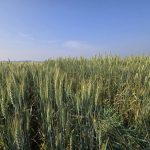Soybean aphids aren’t keen on plants that carry the RAG1 gene, which makes plants that carry the gene popular with farmers.
Soybean aphids are the most serious insect pest facing the Canadian bean industry.
Dale Petrie, general manager of Ontario Soybean Growers, said the aphids are always a worry for farmers and the new soybean variety with the RAG1 gene will be welcomed.
Syngenta Seeds released the RAG1 for the 2009 crop year in the first week of September under its NK brand.
Plant breeder Don McClure said his company was first to receive the gene isolated by plant researchers at the University of Illinois.
Read Also

VIDEO: Green Lightning and Nytro Ag win sustainability innovation award
Nytro Ag Corp and Green Lightning recieved an innovation award at Ag in Motion 2025 for the Green Lightning Nitrogen Machine, which converts atmospheric nitrogen into a plant-usable form.
The challenge with any single-gene-based solution to pest resistance is the ability of insects or disease to mutate and create new pests that can overcome the plants’ resistance.
To overcome this, Syngenta stacked two control systems together. A systemic seed treatment is mandatory with the new non-genetically modified soybean.
“You can’t buy the (aphid) resistant soybean without a seed treatment. Of course, I work for Syngenta, so (Syngenta’s) Cruiser would be the natural choice here,” said McClure.
“By not having to spray, we also open the door to the aphids’ main predator, the (Asian) ladybug. When we spray for the aphid, we also kill a lot of beneficial insects, so this is a great solution for an insect pest,” said McClure.
The next step in the battle against soybean aphids will be to stack other resistant genes along with RAG1, providing multiple modes of action against the aphids.
“RAG2, RAG3, etc. are located at different locations on the chromosome and this bodes well for the future of the technology. That should deal with the insects overcoming the genetic solution to this problem. That is durable technology,” said McClure.
The RAG genes come from soybeans and are not deemed under Canadian regulations as plants with novel traits. This enabled breeders to get the new varieties into farmers’ hands quickly.
A few Ontario and American growers will get the limited supplies of the new RAG1 conventional soybeans to plant in the spring of 2009. In 2010 growers will see Roundup Ready versions. After that, the multiple gene-stacked seed will enter the market, said McClure.
Later this year, researchers are expected to learn why aphids react to RAG1.
McClure said it is ironic that this year, when the product reaches the market, soybean aphids aren’t a severe problem.
Infestations of the bug and drought go hand-in-hand, say entomologists. This year has been damp and cool in much of the aphid’s North American range.
At the University of Illinois where the new variety was developed, Brian Diers and a team that included staff from the United States Department of Agriculture isolated the RAG1 gene from a soybean released in Texas in the 1970s called Dowling.
The group developed molecular markers and used them to screen thousands of germplasm samples to find a resistant gene, said McClure.
“Now they have about seven different genes,” he said. “Without those markers it would have taken a long time to field screen with insects. They are notoriously unreliable.”
Dowling is naturally resistant to soybean aphid infestation. The insects feed for a little while and then stop. This interrupts their seven day life cycle long enough to disrupt the winged females from laying eggs. That eliminates births of wingless females, which otherwise reproduce in cycle after cycle, destroying the crop through feeding, transmission of viral diseases and creation of environments for fungi.
“Once we had that gene, we were able to naturally cross it into some of our best adapted (soybean) lines. So it’s genetically packaged with some of the best soybean seed farmers can plant,” said McClure.
By packaging the plant’s protection inside the seed, growers avoid costly applications of insecticide.
The soybean aphid is a relatively new pest. It is often misidentified and population assessments remain complicated. This can lead to over-application of insecticide and even when the pests reach economic threshold levels when it is advisable to spray, the pesticides kill more than the target insects.
“Whenever we can find a method of control that targets only the pest we need to reach, that is exciting,” said McClure.
Aphis glycines were first discovered in Ontario and Quebec in 2001, a year after their North American debut in Illinois and Ohio.
The bugs likely came from China among nursery stock and have since thrived in Eastern Canada, the American Midwest and Plains and are entrenched in Manitoba.
Where it infested Ontario and Quebec crops in 2001, yields dropped by 50 percent.














